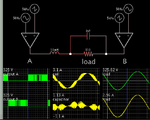baileychic
Advanced Member level 3
True Sinewave Inverter - Output LC filter design help needed
Hi,
I have designed a true sinewave inverter for single phase 220V 50Hz. I am using 12V Battery voltage to 325V DC VBUS voltage DC-DC Converter (not shown in simulation). My SPWM is ok. The issue is I am not getting sinewave signal at the output. Please tell me how to design a good LC output filter.
I used the formula f = 1 / (2Pisqrt(LC))
My SPWM frequency is 16 KHz and so I chose cutoff frequency for filter as 3 KHz. I need 50 Hz fundamental sinewave output. SPWM is ok because if I connect RC low pass filter then I get pure sinewave output. I am attaching my Proteus simulation file. I am also testing on hardware. In both I am getting this distorted signal.
L = 1/(4 * 3.14159265^2 * 3000^2 * 2.2uF)
L = 1.279mH
- - - Updated - - -
I am actually making two versions of the Inverter. One is based on DC-DC Converter with switching transformer to get 325V DC VBUS voltage for H-Bridge from 12V Battery voltage. Another is I am using 12V to 220V step-up output iron core transformer at the H-Bridge output. Now, I changed the inductor and capacitor values and I am getting this signal at the output. It is still not pure sinewave. I know the distortion at ZC is due to Mosfet. How can I eleiminate it to get pure sinewave ? I am using IRF840. See attached image.
Hi,
I have designed a true sinewave inverter for single phase 220V 50Hz. I am using 12V Battery voltage to 325V DC VBUS voltage DC-DC Converter (not shown in simulation). My SPWM is ok. The issue is I am not getting sinewave signal at the output. Please tell me how to design a good LC output filter.
I used the formula f = 1 / (2Pisqrt(LC))
My SPWM frequency is 16 KHz and so I chose cutoff frequency for filter as 3 KHz. I need 50 Hz fundamental sinewave output. SPWM is ok because if I connect RC low pass filter then I get pure sinewave output. I am attaching my Proteus simulation file. I am also testing on hardware. In both I am getting this distorted signal.
L = 1/(4 * 3.14159265^2 * 3000^2 * 2.2uF)
L = 1.279mH
- - - Updated - - -
I am actually making two versions of the Inverter. One is based on DC-DC Converter with switching transformer to get 325V DC VBUS voltage for H-Bridge from 12V Battery voltage. Another is I am using 12V to 220V step-up output iron core transformer at the H-Bridge output. Now, I changed the inductor and capacitor values and I am getting this signal at the output. It is still not pure sinewave. I know the distortion at ZC is due to Mosfet. How can I eleiminate it to get pure sinewave ? I am using IRF840. See attached image.








